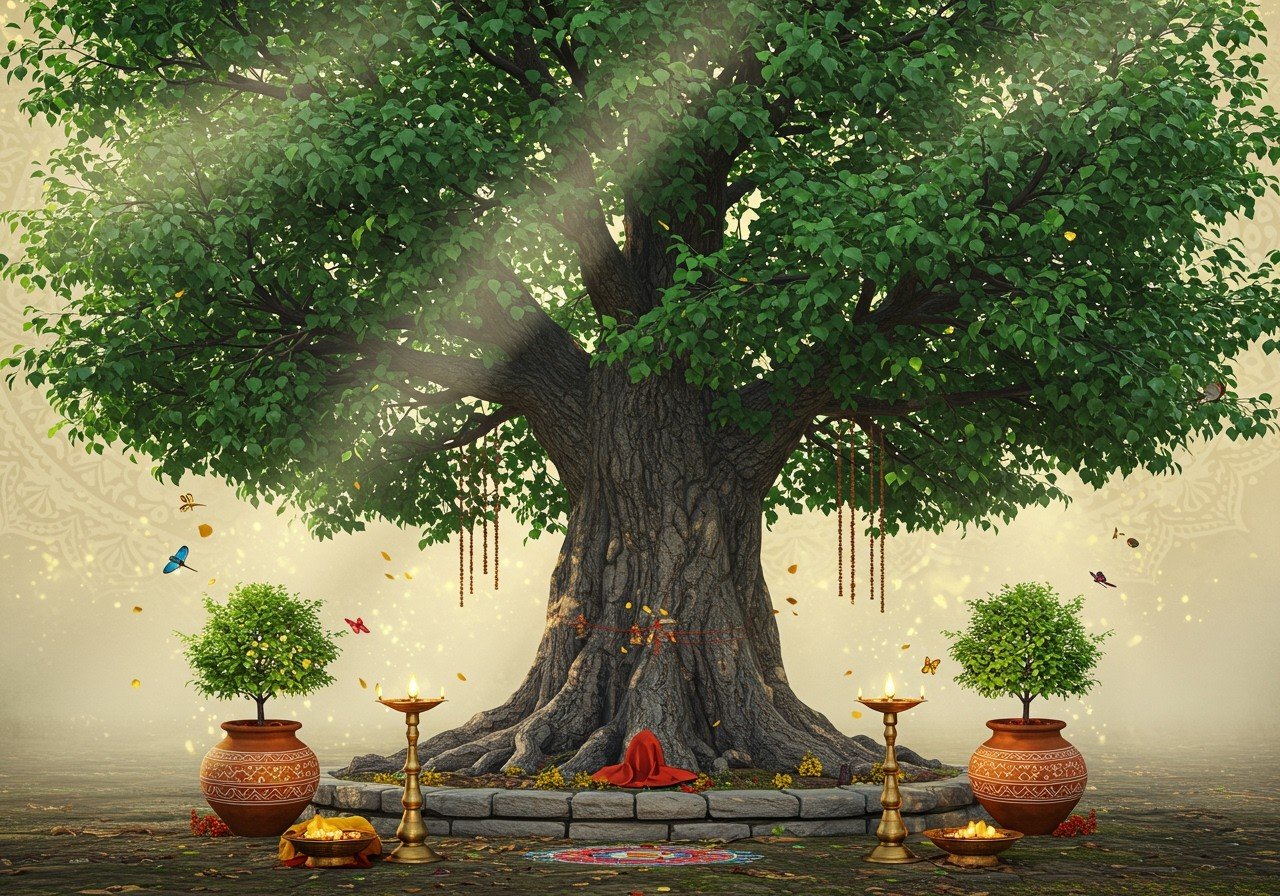
The Peepal tree, scientifically known as Ficus Religiosa, holds profound significance in Indian culture and traditions. Revered for its spiritual symbolism and medicinal properties, it’s an integral part of our heritage. Let’s delve into the captivating world of the Peepal tree, exploring its significance, lifespan, care, and the rich cultural tapestry it weaves.
Understanding the Peepal Tree’s Natural Habitat
The Peepal tree flourishes in the tropical and subtropical climates of the Indian subcontinent, Nepal, and Sri Lanka. It thrives under the abundant sunlight and in well-drained soil, often gracing temple courtyards, roadsides, and even urban environments, demonstrating its adaptability. As a keystone species, it supports a rich biodiversity, providing shelter and sustenance to various birds and insects, contributing significantly to the ecological balance.
The Remarkable Lifespan of the Peepal Tree
Known for its exceptional longevity, the Peepal tree often lives for centuries, embodying resilience and endurance. This remarkable lifespan is attributed to its robust root system and remarkable regenerative abilities. Its roots delve deep and spread wide, anchoring it firmly and providing access to essential nutrients. Even when felled, it can sprout anew from its cuttings, a testament to its enduring spirit. This characteristic underscores its symbolic association with continuity and unwavering strength in Indian culture. Take, for instance, the sacred Bodhi tree in Bodh Gaya, under which Lord Buddha attained enlightenment, a living testament to the Peepal’s enduring nature, believed to be over 2,500 years old.
Caring for the Sacred Peepal: A Guide for Devotees
Whether you’re nurturing a Peepal tree in your garden or a pot, understanding its needs is crucial. Here’s a comprehensive guide to ensure your Peepal tree thrives:
Light
- Sunlight is vital: The Peepal tree thrives in bright, indirect light. Position it near a window where it can bask in ample sunlight, yet shielded from harsh, direct rays that could scorch its delicate leaves.
- Direct sunlight requirement: Aim for at least six hours of direct sunlight daily to promote healthy growth. If growing indoors, consider grow lights as a supplement.
Watering
- Moderate watering is key: Water your Peepal tree only when the top inch of the soil feels dry. Overwatering can lead to root rot, so ensure proper drainage and avoid letting the tree stand in water.
- Seasonal adjustments: Reduce watering during winter as the growth slows. They are known to handle brief dry periods efficiently.
Humidity
- High humidity is preferred: True to its tropical origins, the Peepal tree loves humidity. Using a humidifier, placing a pebble-filled water tray beneath the pot, or regular misting can help maintain ideal moisture levels.
- Protecting after misting: When misting, shield the plant from direct sunlight. This prevents water droplets from magnifying the sun’s rays and burning the leaves. It’s especially important in winter when indoor heating dries the air quickly.
Temperature
- Maintaining the right temperature: Keep your Peepal tree warm, ideally between 16-29°C (60-85°F). Avoid sudden temperature changes and drafts. Optimal summer temperatures fall between 18-23°C (64.4-73.4°F). During colder months, protect it from falling below 16°C (60.8°F).
- Protecting from temperature fluctuations: Fluctuations in temperature can cause unnecessary stress and weaken the tree. It can lead to leaf drop or discoloration if the temperature swings too drastically.
Soil
- Well-draining soil is essential: Use a well-draining soil mix, ideally one formulated for indoor trees or general houseplants. This ensures the roots stay healthy and prevents waterlogging.
- Enhancing drainage for potted plants: For potted Peepal trees, a blend of potting compost and sharp sand (in a 70:30 ratio) is ideal, enhancing drainage and aeration.
Fertilizing
- Regular feeding: Nourish your Peepal tree with a balanced, water-soluble fertilizer every month during the growing season (spring and summer). Refrain from fertilizing during the dormant winter months.
- Alternative feeding schedules: A slow-release granular fertilizer can be used as well, typically applied every three months during the warmer periods.
Pruning
- Maintaining shape and size: Regular pruning, ideally during late winter or early spring, helps maintain the Peepal tree’s shape and size, particularly crucial for indoor plants.
- Pruning techniques: Use sharp, clean pruning shears and make cuts just above a node. Removing dead or diseased branches promotes healthier growth.
Potting and Repotting
- Choosing the right pot: Select a pot that provides ample room for the roots to grow. As the tree matures, a sturdy, larger container becomes necessary to accommodate its expanding stature.
- Repotting: Repot every two years, preferably during spring, to replenish the soil and provide more space for the roots. After repotting, place the tree in indirect light and maintain consistent moisture, avoiding overwatering.
Common Problems and Solutions
- Yellowing leaves: Often indicate overwatering, poor drainage, or nutrient deficiency. Adjust watering practices and ensure good drainage.
- Leaf drop: Can be caused by environmental stressors like temperature fluctuations, underwatering, or overwatering. Stabilize the environment and adjust watering.
- Stunted growth: Insufficient light, overwatering, or nutrient-poor soil can hinder growth. Provide adequate light, adjust watering, and consider fertilizing.
- Root rot: Primarily caused by overwatering. Ensure proper drainage and allow the soil to dry between waterings.
- Leaf spot: Fungal or bacterial infections cause leaf spots. Improve air circulation, avoid wetting the leaves, and remove affected ones.
Dealing with Pests
- Common pests: Peepal trees can be susceptible to aphids, spider mites, and mealybugs.
- Natural pest control: Address aphid infestations by washing them off with water or using insecticidal soap. For spider mites, increase humidity and wipe the leaves with a damp cloth. Insecticidal soap or neem oil can be used for persistent infestations.
For all your puja needs and to enhance your spiritual practices, explore the diverse range of authentic puja items available at Poojn.in. We offer everything from holy utensils to holy cosmetics, jari booti, and holy clothing.
The Cultural and Religious Significance of Ficus Religiosa
Deeply rooted in Indian culture and spirituality, the Peepal tree is revered across various faiths. In Hinduism, it is associated with Lord Vishnu and embodies the Trimurti – Brahma, Vishnu, and Mahesh. Buddhists venerate it as the Bodhi tree, under which Siddhartha Gautama achieved enlightenment, becoming the Buddha. Jains also hold the tree in high regard. Festivals like Vat Purnima celebrate its sanctity, strengthening the bond between devotees and this sacred tree. Beyond its spiritual significance, the Peepal tree finds its place in traditional medicine, particularly Ayurveda, where its leaves, bark, and roots are used for various remedies.
At Poojn.in, we understand the deep reverence for the Peepal tree. We offer a curated collection of items to facilitate your worship, including pure copper water vessels, traditional cotton wicks, natural ghee and oil diyas, sacred threads (mauli/kalava), copper coins, organic kumkum and rice, and handcrafted brass bells. We ensure the authenticity and purity of these items, delivering them right to your doorstep across India.
Embracing the Timeless Legacy of the Peepal Tree
The Peepal tree, a symbol of resilience, spirituality, and cultural heritage, continues to inspire awe and reverence. Its ability to thrive through centuries connects us to the timeless rhythm of nature and our ancestral roots. Whether nurturing it in our gardens or honoring it in rituals, we participate in a living tradition. The Peepal tree’s strength and grace serve as a potent reminder of our enduring values. By understanding and respecting its significance, we ensure its legacy lives on, inspiring and connecting generations to come.


